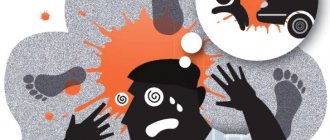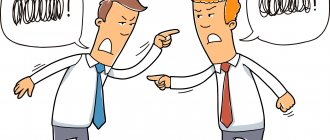In MK10, recurrent depressive disorder is coded F33. Recurrent depression with repeated depressive episodes without previously occurring independent periods of elation and elevation of mood. Treatment with antidepressants sometimes causes a slight increase in mood and increased activity after a depressive episode. Recurrent depression occurs more often in men than in women. Doctors at the Yusupov Hospital take an individual approach to the choice of drugs to interrupt the current episode and long-term treatment of the disease. Medical staff respects the psychological problems of patients.
Psychotherapists use the most effective methods of psychotherapy. During long-term preventive therapy, psychoeducational work and constant monitoring of the patient’s condition are carried out. Social disadaptation, professional decline and disability of the patient are caused not by a separate depressive episode, but by recurrence - the return of symptoms of the disease. In this regard, psychiatrists not only treat the current depressive episode, but also take measures to prevent the development of new episodes of depression. Premature cessation of antidepressant therapy significantly increases the likelihood of relapse of current depression and the emergence of new depressive phases.
Reasons for the development of the disease
Recurrent mood disorder, according to modern scientists, can be caused by several factors:
- Endogenous - the presence of a genetic predisposition.
- Psychogenic - a person usually reacts to mental trauma with depression.
- Organic. Depression can be a consequence of traumatic brain injury, intoxication, neuroinfections, residual organic inferiority, and so on.
The first manifestations of the disease are usually provoked by external influences, most often these are traumatic circumstances. But, repeated phases can be triggered by factors that are not related to external influences.
Features of the disease
Features of the disease are manifested in the following:
Attacks occur acutely, usually in the cold season
Women are much more prone to this disease than men
This depressive state can develop into bipolar affective disorder.
There are three main degrees of severity:
In mild cases, the disease practically does not interfere with the patient’s ability to perform usual professional and household functions.
The average degree is expressed in the complexity of communication; a person is able to continue to communicate with people and work, but this already causes certain difficulties in him
The last and most severe degree of the disease is expressed in his inability to perform normal daily activities (get out of bed, eat, drink), the patient is often visited by suicidal thoughts.
Pathogenesis
Typically, a person reaches adulthood when they are diagnosed with recurrent depressive disorder. Symptoms appear after forty years of age and can last from three months to a year, and the clear intervals should be at least eight weeks. The older the patient, the higher the likelihood that the disease will become chronic. The duration of the attack is directly proportional to the duration of the disease, sometimes it takes on a seasonal character.
Symptoms of recurrent depressive disorder
The psychotherapist assesses the patient’s condition, the severity of his illness, while simultaneously developing a plan for his treatment. The most terrible condition of any disease is a relapse. Each relapse of a recurrent disorder accompanies the patient with the following symptoms:
It is impossible to concentrate attention on certain things, on making important decisions in the professional and personal sphere.
Negative attitude towards your past, present and future.
Depressed state with a feeling of hopelessness (the patient is constantly visited by negative thoughts and emotions)
Appetite changes (increases or decreases)
Sleep disturbance (insomnia, waking up in the middle of the night with inability to fall back to sleep, constant desire to sleep)
Lack or loss of strength and energy
Low self-esteem, no self-confidence.
Typically, the onset of the disease is much later than bipolar affective disorder. The age of development of the disorder is 30-40 years, the gender prone to the disease is women. The duration of the disease is 5-6 months, after which remissions occur (1.5-2 months).
Notes
- ↑ 1234
Disease ontology database (English) - 2021. - ↑ 1234
Monarch Disease Ontology release 2018-06-29sonu - 2018-06-29 - 2018. - ↑ 1 2 3 4 5 6 7 8 American Psychiatric Association.
Diagnostic and Statistical Manual of Mental Disorders, Fifth Edition (DSM-5). - Arlington, VA: American Psychiatric Publishing, 2013. - P. 160-162. — 992 p. — ISBN 978-0-89042-554-1. — ISBN 978-0-89042-555-8. — ISBN 0-89042-554-X. - World Health Organization.
International Classification of Diseases (10th revision). Class V: Mental and behavioral disorders (F00-F99) (adapted for use in the Russian Federation). - Rostov-on-Don: “Phoenix”, 1999. - P. 156-157. — ISBN 5-86727-005-8. - Stahl SM, Morrissette DA, Faedda G., Fava M., Goldberg JF, Keck PE, Lee Y., Malhi G., Marangoni C., McElroy SL, Ostacher M., Rosenblat JD, Solé E., Suppes T., Takeshima M., Thase M.E., Vieta E., Young A., Zimmerman M., McIntyre RS
Guidelines for the recognition and management of mixed depression. (English) // CNS Spectrums. — 2021. — April (vol. 22, no. 2). - P. 203-219. - doi:10.1017/S1092852917000165. — PMID 28421980. [] - ↑ 1 2 Yu.V. Kannabikh.
History of psychiatry. - L.: State Medical Publishing House, 1928. - ↑ 1 2
FGBNU NTsPZ.
‹‹Depression in general medicine: A guide for doctors›› (undefined)
. www.psychiatry.ru. Access date: April 22, 2021. - Charles F. Reynolds, Vikram Patel.
Screening for depression: the global mental health context (English) // World Psychiatry (English) Russian.. - Wiley-Blackwell, 2017-10. - Vol. 16, iss. 3. - P. 316-317. - doi:10.1002/wps.20459. - Zung WW (1965) A self-rating depression scale. Archives of General Psychiatry 12: 63-70 PMID 14221692
- Beck AT et al. An Inventory for Measuring Depression //Archives of general psychiatry. - 1961. - T. 4. - No. 6. - pp. 561-571.
- PHQ-9 Screener-Phizer (undefined)
. - Bech P, Rasmussen NA, Olsen LR, Noerholm V, Abildgaard W. The sensitivity and specificity of the Major Depression Inventory, using the Present State Examination as the index of diagnostic validity. J Affect Disord 2001; 66: 159—164 PMID 11578668
- K Pajer et al.
Discovery of blood transcriptomic markers for depression in animal models and validation in subjects with early-onset major depression (English) // Translational Psychiatry (English) Russian. : journal. - 2012. - Vol. 2, no. e101. - doi:10.1038/tp.2012.26. - Podkorytov V.S., Chaika Yu.Yu.
Depression and resistance // Journal of psychiatry and medical psychology. - 2002. - No. 1. - P. 118-124. - ↑ 1 2 3 4 5 Bykov Yu. V.
Treatment-resistant depression. - Stavropol, 2009. - 74 p. - Vereitinova V.P., Tarasenko O.A.
Side effects of antidepressants // Pharmacist. - 2003. - Issue. 14. - Comparative efficacy and acceptability of 12 new-generation antidepressants: a multiple-treatments meta-analysis: The Lancet
- Mosolov S. N.
Basics of psychopharmacotherapy. - Moscow: Vostok, 1996. - 288 p. - Combination of Antidepressant Medications From Treatment Initiation for Major Depressive Disorder: A Double-Blind Randomized Study (unspecified)
(inaccessible link). Date accessed: February 21, 2021. Archived April 3, 2021. - Bykov Yu. V., Bekker R. A., Reznikov M. K.
Resistant depression. Practical guide. - Kyiv: Medkniga, 2013. - 400 p. — ISBN 978-966-1597-14-2. - Wiles N, Thomas L, Abel A, Ridgway N
et al .
Cognitive behavioral therapy as an adjunct to pharmacotherapy for primary care based patients with treatment resistant depression: results of the CoBalT randomized controlled trial (English) // The Lancet. - Elsevier, 2013 Feb 2. - Vol. 381, no. 9864. - P. 375-384. - doi:10.1016/S0140-6736(12)61552-9. - PMID 23219570. - Robert A. Bell, PhD, Peter Franks, MD, Paul R. Duberstein, PhD, Ronald M. Epstein, MD, Mitchell D. Feldman, MD, MPhil, Erik Fernandez y Garcia, MD, MPH and Richard L. Kravitz, MD , M.S.P.H.
Suffering in Silence: Reasons for Not Disclosing Depression in Primary Care (English) // Annals of Family Medicine: journal.
- 2011. - Vol. 9. - P. 439-446. - doi:10.1370/afm.1277. (PDF (unspecified)
. Archived May 30, 2012.) Abstract in Russian: Why are patients silent about depression?
(undefined)
. - Breslau, N. et al.
Headache and major depression
(undefined)
. Neurology (1999). Archived May 30, 2012. - Breslau, N. et al.
Migraine and Major Depression: A Longitudinal Study (English) // Headache: The Journal of Head and Face Pain: journal. - July 1994. - Vol. 34, no. 7. - P. 387-393. - doi:10.1111/j.1526-4610.1994.hed3407387.x. - Psychiatric disorders among Egyptian pesticide applicators and formulators. By Amr MM, Halim ZS, Moussa SS. In Environ Res. 1997;73(1-2):193-9. PMID 9311547
- Depression and pesticide exposures among private pesticide applicators enrolled in the Agricultural Health Study. By Beseler CL, Stallones L, Hoppin JA, Alavanja MC, Blair A, Keefe T, Kamel F. In: Environ Health Perspect. 2008 Dec; 116(12):1713-9.PMID 19079725
- A cohort study of pesticide poisoning and depression in Colorado farm residents. By Beseler CL, Stallones L. In Ann Epidemiol. 2008 Oct; 18(10):768-74.PMID 18693039
- Mood disorders hospitalizations, suicide attempts, and suicide mortality among agricultural workers and residents in an area with intensive use of pesticides in Brazil. By Meyer A, Koifman S, Koifman RJ, Moreira JC, de Rezende Chrisman J, Abreu-Villaca Y. In J Toxicol Environ Health A. 2010; 73(13-14):866-77. PMID 20563920
- Suicide and potential occupational exposure to pesticides, Colorado 1990—1999, By Stallones L. In J Agromedicine. 2006; 11(3-4):107-12. PMID 19274902
- Increased risk of suicide with exposure to pesticides in an intensive agricultural area. A 12-year retrospective study. Di Parrón T, Hernández AF, Villanueva E. In Forensic Sci Int. 1996 May 17; 79(1):53-63.PMID 8635774
- Martha H. Vitaterna, Fred W. Turek, Andrew Kasarskis, John J. Renger, Christopher J. Winrow.
Cross-species systems analysis identifies gene networks differentially altered by sleep loss and depression // Science Advances. — 2018-07-01. - Vol. 4, iss. 7. - P. eaat1294. — ISSN 2375-2548. - doi:10.1126/sciadv.aat1294. - Depression: symptoms and treatment of depression
Severity of the disease
This disease has quite a variety of clinical manifestations. There are three degrees of severity of the disease: mild, moderate and severe. With a mild degree, the patient exhibits 2-3 main symptoms of the disease. Moderate severity is accompanied by a large number of symptoms; this degree is much more serious than mild. And finally, the severe degree. In this case, the person exhibits all the main symptoms and the functionality of the internal organs is disrupted. Usually, with this advanced condition, a person needs hospitalization.
Types of disorder
According to the specific manifestations, recurrent depression is divided into the following types:
- premenstrual;
- seasonal;
- anxious;
- asthenic;
- apathetic.
Premenstrual depression occurs only in women, and episodes occur regularly, about a week before menstruation. The disorder is characterized by a short duration of symptoms (7-10 days), mild or moderate severity.
Seasonal depression is a type of recurrent depressive disorder in which episodes recur in the fall and winter.
The anxiety form of recurrent depression is a disorder that combines symptoms of depressive and anxiety disorders. Pathology often occurs against the background of panic attacks and phobias.
The asthenic form is accompanied by a strong loss of strength, constant physical and emotional fatigue. With apathetic recurrent depression, symptoms such as apathy, loss of the opportunity to enjoy life, and psychomotor retardation come to the fore.
Melancholic and anxious depression
In classical psychiatry, it is customary to distinguish melancholic and anxious depression, although the disorder is not limited to these forms.
Melancholic depression is the most severe form. Patients experience “vital” melancholy - it is described as physical pain in the soul, chest, neck, head. A person lies in bed for days facing the wall, stops talking and caring for himself. Nothing brings pleasure, even what he used to love very much. They have persistent thoughts of suicide, which are prevented from being realized only by a general loss of strength.
Important
Suicidal thoughts and intentions can be hidden from others, so depression requires the supervision of an experienced psychotherapist.
Anxious depression is expressed in hypochondriacal ideas (premonitions of non-existent diseases), anxiety due to negative future scenarios, pronounced vegetative-somatic manifestations - palpitations, chills, cold sweats, digestive disorders.
Prevalence
This diagnosis is more common among residents of large cities, because in the “human anthill” you can feel lonely like nowhere else. Overcrowding, poor environment, constant stress, excessive demands on oneself and the desire to succeed certainly put pressure on the human psyche, causing it to experience overload. The fact that people living in cities are more likely to decide to go to the doctor and find out their diagnosis also plays a role.
Somatic, especially neurological diseases increase depression. Constant headaches or heart pain can make a person think about his imminent death. Overly strict upbringing, stress and trauma in early childhood, and episodes of domestic violence also play a big role. Heredity also plays a role.
Features of age
In adolescence, the risk of suicide attempts and destructive behavior increases compared to depression in later life. In this period of life, there is significant emotional lability, a tendency towards maximalism and great vulnerability. The classic version of melancholic depression with melancholy and loss of vitality is rarely encountered, which is replaced by the two most common types - apathetic and dysphoric.
In old age, symptoms appear more subdued. Instead of classic melancholy, asthenia, anergy, and increased fatigue occur. High tendency to attach an anxiety component. There is fear of the present and the future, while at the same time the past is depicted in less pessimistic tones. Depression in older people is often difficult to identify because its symptoms are ignored and attributed to age-related changes in a person’s mental state.
Literature
- A. S. Tiganov, A. V. Snezhnevsky, D. D. Orlovskaya, etc.
Guide to psychiatry in 2 volumes / Ed. Academician of the Russian Academy of Medical Sciences A. S. Tiganov. - M.: "Medicine", 1999. - T. 1. - 712 p. — ISBN 5-225-02676-1.
In the Brockhaus-Efron encyclopedic dictionary
- Melancholy // Encyclopedic Dictionary of Brockhaus and Efron: in 86 volumes (82 volumes and 4 additional). - St. Petersburg, 1890-1907.
- Taedium vitae // Encyclopedic Dictionary of Brockhaus and Efron: in 86 volumes (82 volumes and 4 additional). - St. Petersburg, 1890-1907.
Consequences
The disease significantly exhausts the body and lowers immunity. The functioning of the cardiovascular and endocrine systems deteriorates. A person who is prone to depression loses his ability to work and cannot be in society. This condition does not lead to anything good. In 2% of patients, relapses of bad mood can even lead to death - suicide.
Diagnosis of the disease
A psychotherapist diagnoses recurrent depression if attacks occur periodically. This form of depression differs from others in that the episodes recur after several months and last about two weeks, while the person suffers from apathy and bad mood.
Does the doctor necessarily check whether the patient has a serious mental illness? Quite often, recurrent depression accompanies various pathologies. It can occur in three forms of varying degrees:
- Mild degree has two main and the same number of additional somatic symptoms.
- The average degree is characterized by two main symptoms and four additional ones. When the number of symptoms decreases, the disease becomes more complex.
- Severe degree is characterized by all the main symptoms and four additional ones. Sometimes in advanced cases delirium, hallucinations, and stupor appear.
Diagnostic measures
According to the World Health Organization and Russian clinical guidelines, for recurrent depression, the diagnosis is made based on certain criteria. These include:
- A decrease in mood is observed for 14 days or more, and does not depend on the time of day.
- Symptoms include low mood, decreased interest or enjoyment in activities that previously evoked positive emotions, and a general decrease in energy levels leading to fatigue.
- There are no manic symptoms.
- The patient did not take psychoactive substances and does not have organic brain damage.
If a patient meets all four diagnostic criteria, they may be diagnosed with recurrent depression. It is important to note that in addition to collecting complaints and medical history, the psychiatrist also conducts additional examination methods. The most commonly used are electroencephalography (EEG) and magnetic resonance imaging (MRI). The methods assess the functional activity and structural integrity of the brain, respectively.
General clinical studies are also carried out: ECG, clinical and biochemical blood tests, general urine analysis, etc. They are aimed at identifying concomitant diseases that may affect the effectiveness of the therapy.
Treatment
Treatment of this disease begins with an examination of the general health of the patient. In parallel, a differential diagnosis is carried out aimed at identifying recurrent depressive syndrome and excluding the possibility of another mental disorder.
Treatment of the disease is carried out using:
- Antipsychotic drugs
- Antidepressants
- Inhibitor
- Benzodiazepines.
There are contraindications, you need to consult a specialist!
The use of cognitive, psychodynamic, non-directive, rational, interpersonal and group psychotherapy is effective. Treatment may be complicated by the difficulty of diagnosing the manifesting abnormality.
Recurrent depressive disorder cannot be diagnosed at home using psychological techniques. Only a psychiatrist can make a diagnosis. Psychiatrists also treat the disease.
Principles of therapy
Elimination of prolonged recurrent depression, as well as its other forms, can take place in an outpatient clinic or a neuropsychiatric dispensary. This is decided by the attending physician based on the severity of the pathology.
The basis of therapy is the use of antidepressants. Their dosage is selected individually, and the total duration of treatment can reach several years. In addition to pharmacological medications, the patient needs long-term psychotherapy. Preference is given to the behavioral or interpersonal direction.
All therapy for recurrent depression is divided into three stages: relieving, stabilizing and preventive. In each case, treatment is selected only by a psychiatrist. Self-administration of medications or their withdrawal is unacceptable.
Relieving treatment
The main goal of the first stage of therapy is to eliminate acute symptoms and ensure remission. For this purpose, tricyclic antidepressants (Amitriptyline, etc.) are prescribed in standard dosages. The effectiveness of the treatment is assessed within 4 weeks. If there are no positive results, then the drug is replaced and the patient is observed for another 2 weeks. If there is no effect, an additional replacement of the drug is made.
On the subject: Pills for depression
Maintenance therapy
Patients with depressive disorder require long-term treatment, including after acute symptoms have resolved. Maintenance therapy can reduce the risk of relapse. In its absence, 50% of patients experience recurrent signs of the disease within six months after discontinuation of treatment. The average duration of the therapeutic stage is 6 months.
Maintenance therapy is recommended to be carried out with the same antidepressant that was used during the relief of acute symptoms. Its dosage remains the same or may be reduced.
Preventive stage
Prevention using medications helps avoid delayed relapses. Medical statistics show that 75% of patients without taking antidepressants relapse into depressive disorder within 2-3 years. However, maintenance therapy has its own indications:
- two or more depressive episodes in history;
- development of the disease in adolescence or old age;
- short interval between clinical exacerbations;
- cases of depressive disorders in the family;
- presence of concomitant mental illnesses.
For maintenance therapy, any antidepressants are selected. Their dosage should not be less than therapeutic. The average duration of preventive treatment is 2-3 years, but not less than 12 months. It is not canceled in cases where there are no symptoms of depressive disorder, as this may provoke a relapse.
Withdrawal from antidepressants requires a gradual reduction in dosage over 4 weeks or more. Compliance with the drug withdrawal regime helps prevent the return of symptoms.
Psychotherapeutic assistance
An important part of the treatment of recurrent depression is psychotherapy. Psychiatrists recommend several approaches: individual, group and family sessions. In individual psychotherapy, a specialist helps the patient change an inadequate perception of himself to an objective one. This allows the patient to understand the cause of unpleasant emotions and symptoms, gradually eliminating the clinical manifestations of the pathology.
Group psychotherapy improves a person’s ability to build harmonious relationships with other people. At the same time, he begins to feel a sense of belonging to the group and notes an increased sense of security. Thanks to long-term psychotherapeutic assistance, anxiety decreases, self-esteem improves and adequate life plans appear.
Family psychotherapy is aimed at improving the social abilities of the patient himself and his family members. Loved ones are often a source of stress that maintains depression. When their attitude towards the patient changes, for example, the severity of blaming behavior decreases, the person’s condition improves.
The duration of psychotherapeutic therapy varies from person to person. It is recommended to begin treatment with individual sessions. After acute symptoms have decreased, family and group interpersonal psychotherapy is possible.
Prevention
At the moment, no effective methods have been developed to prevent the disorder. To reduce the likelihood of progression of the disorder, the patient should promptly seek medical help if any of its symptoms develop. Stress disorders should also be minimized to reduce the likelihood of progression of the disorder.
Related posts:
- How to deal with depression Depression is, as you know, a mental disorder in which a person...
- Psychosis Psychosis is a complex mental disorder that may have an underlying...
- Schizophrenia in children Schizophrenia in children is a mental disorder with psychotic symptoms and chronic…
- Cortisol in children: what does a high level mean? The adrenal glands produce the hormone cortisol and adrenaline, which is often associated with...
Historical information
The modern concept of depression is similar to the older concept of melancholy. Melancholy concept
originates from “black bile,” one of the “four temperaments” described by Hippocrates.
In the Middle Ages, however, many of the scientific achievements of ancient doctors were lost, and major depressive disorder
has long been regarded as “possession by the Devil.” The appropriate treatment was offered: rites of exorcism of the Devil, fasting or fasting, prayers. Patients with severe depressive agitation were asked to be tied up and subjected to beatings. During the Inquisition, depressive patients with ideas of self-accusation were fertile material for inquisitors[6]. The revival of the approach to depression as a disease requiring medical intervention and treatment, and not rites of exorcism, began only in the late Middle Ages, during the era of the Renaissance and the growing interest in antiquity and its achievements. The first classification of psychoses was invented by Felix Shater (1537-1614), where depression appears under the term Melancholia in the class Mentis alienatio - a group of psychoses in the literal sense of the word [6].











